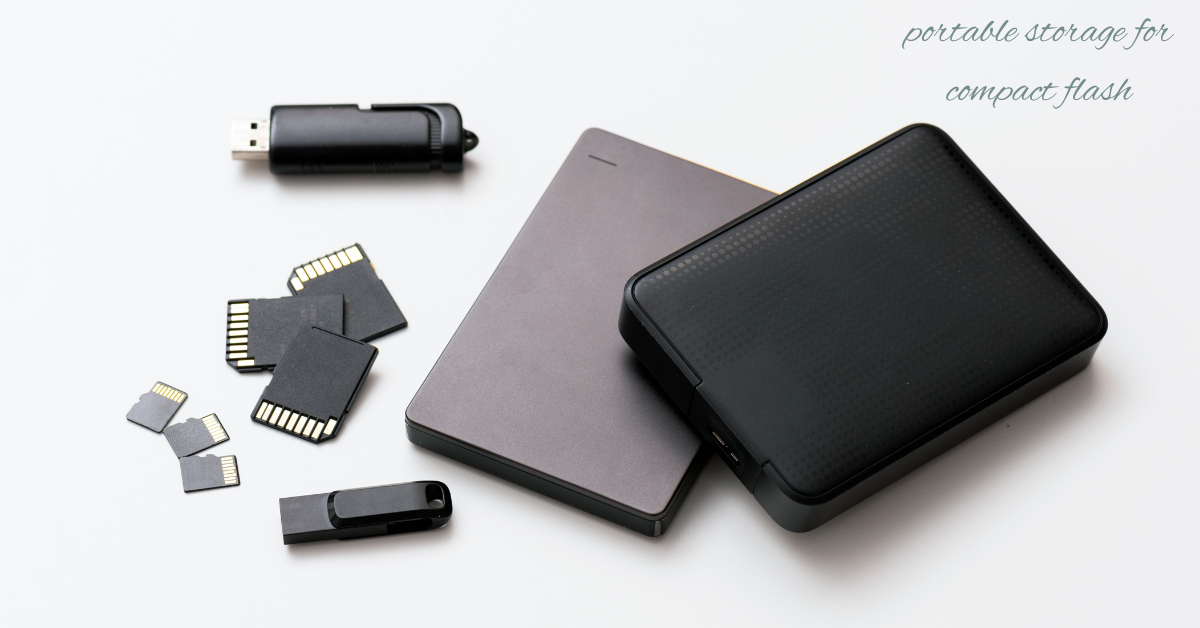Introduction
Compact Flash (CF) cards are widely used in professional photography, videography, and other applications requiring reliable and high-capacity storage. Managing and backing up data from CF cards is crucial, especially when on the go. Portable storage solutions for Compact Flash cards provide a convenient and efficient way to store, transfer, and protect your data. This comprehensive guide explores the different types of portable storage options for CF cards, their benefits, key features, and tips for selecting and using them effectively.
Understanding Compact Flash Cards
What Are Compact Flash Cards?
Compact Flash cards are a type of memory card known for their durability and high storage capacity. They are commonly used in professional cameras, video recorders, and industrial applications. CF cards come in various capacities and speeds, making them suitable for high-performance tasks.
Importance of Portable Storage for CF Cards
- Data Backup: Portable storage provides a way to back up data from CF cards, ensuring that valuable files are not lost due to card failure or damage.
- Data Transfer: Portable storage solutions enable quick and easy transfer of data from CF cards to other devices, such as computers or external hard drives.
- On-the-Go Convenience: For professionals working in the field, portable storage allows for immediate data backup and transfer without the need for a stationary setup.
Types of Portable Storage Solutions for Compact Flash Cards
Portable Hard Drives and SSDs
- External Hard Drives: These devices offer large storage capacities and are ideal for backing up and storing large volumes of data from CF cards. They connect to devices via USB, Thunderbolt, or other interfaces.
- Portable SSDs: Solid State Drives (SSDs) provide faster data transfer speeds and are more durable than traditional hard drives. They are lightweight and compact, making them perfect for on-the-go use.
CF Card Readers with Built-In Storage
Some portable card readers come with built-in storage, combining the functions of a card reader and a storage device. These devices allow for direct transfer and storage of data from CF cards.
Wireless Portable Storage
Wireless portable storage devices create a Wi-Fi network that allows multiple devices to connect and transfer data without the need for physical connections. These devices often include built-in batteries for true portability.
Multi-Card Backup Devices
These specialized devices are designed to back up data from multiple types of memory cards, including CF cards. They typically feature a built-in screen for managing backups and verifying data integrity.
Benefits of Portable Storage for Compact Flash Cards
Data Security
Portable storage solutions help protect your data by providing a backup option. In the event of a CF card failure or data corruption, having a backup ensures that your files are not lost.
Convenience
Portable storage devices offer a convenient way to manage and transfer data from CF cards. They eliminate the need for multiple devices and cables, streamlining your workflow.
Portability
Designed for use on the go, these storage solutions are compact and lightweight, making them easy to carry and use in various locations, whether in the field, at a client’s site, or while traveling.
Increased Storage Capacity
With high-capacity portable storage devices, you can store large amounts of data from multiple CF cards, reducing the need to carry multiple cards and providing ample space for backups.
Key Features to Look For
Storage Capacity
Choose a storage device with sufficient capacity to meet your needs. Consider the size of the files you typically work with and the number of CF cards you need to back up.
Transfer Speed
Look for devices with high data transfer speeds to minimize the time required for backups and transfers. SSDs generally offer faster speeds than traditional hard drives.
Connectivity Options
Ensure the device offers compatible connectivity options, such as USB, Thunderbolt, or wireless connections. Multiple connectivity options can enhance flexibility and compatibility with various devices.
Durability
For on-the-go use, select a storage device that is rugged and durable, with features such as shock resistance, water resistance, and robust casing to protect against physical damage.
Power Source
Consider whether the device is battery-powered or requires an external power source. Battery-powered devices offer greater portability, while those requiring external power may be more suitable for stationary use.
Ease of Use
Look for devices with user-friendly interfaces and features, such as built-in screens for managing backups, one-touch backup buttons, and intuitive software for data management.
Tips for Selecting the Perfect Portable Storage Solution
Assess Your Needs
Determine your specific needs, including the volume of data you need to back up, the environments in which you will be using the device, and the types of devices you will be transferring data to and from.
Compare Specifications
Evaluate the specifications of different devices, focusing on storage capacity, transfer speed, connectivity options, and durability. Choose a device that meets your requirements and offers the best value.
Read Reviews
Look for reviews and ratings from other users to gain insights into the performance and reliability of different portable storage devices. User feedback can provide valuable information on ease of use, durability, and customer support.
Consider Future Needs
Select a device that can accommodate your future needs as well as your current ones. Investing in a high-capacity, versatile solution can save money in the long run by avoiding frequent upgrades.
Check Warranty and Support
Ensure the device comes with a warranty and reliable customer support. A good warranty and customer service can offer peace of mind and assistance if any issues arise.
Using Portable Storage for Compact Flash Cards Effectively
Pre-Use Setup
- Charge the Device: Ensure the device is fully charged if it is battery-powered, or connect it to a power source.
- Install Necessary Software: Download and install any required software or drivers for the device on your computer or other devices.
- Format the Storage: Format the storage device if necessary to ensure it is ready for use and compatible with your devices.
During Use
- Safely Connect Devices: Connect your CF card to the portable storage device using the appropriate card reader or built-in slot.
- Initiate Backup: Follow the device’s instructions to initiate the backup or transfer process. Use any built-in screens or software interfaces to manage the process.
- Monitor Transfer: Monitor the data transfer to ensure it completes successfully and without errors.
Post-Use Maintenance
- Safely Eject Devices: Always safely eject the CF card and portable storage device to prevent data corruption.
- Regularly Check Storage: Periodically check the storage device for any issues or errors and ensure backups are intact and accessible.
- Store Properly: Store the portable storage device in a safe, dry place when not in use to protect it from physical damage and environmental factors.
Conclusion
Portable storage solutions for Compact Flash cards are essential tools for professionals who need to manage and back up data on the go. By understanding the different types of portable storage options, their benefits, and key features, you can select the perfect device for your needs. Proper setup, usage, and maintenance ensure that your portable storage device will provide reliable performance and protect your valuable data, enhancing your productivity and peace of mind. Investing in the right portable storage solution can lead to more efficient workflows and secure data management, whether you are in the field or at the office.



